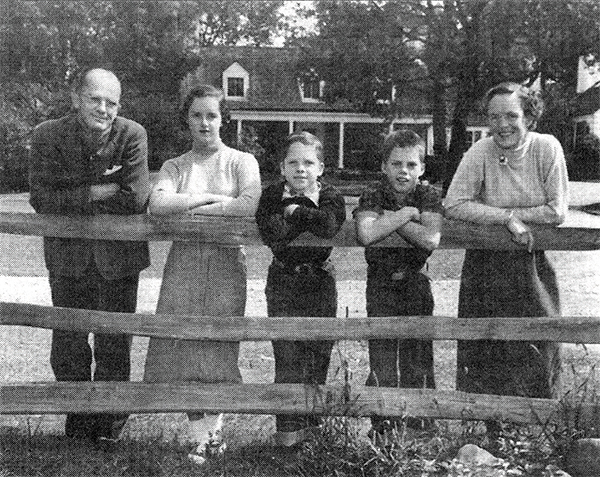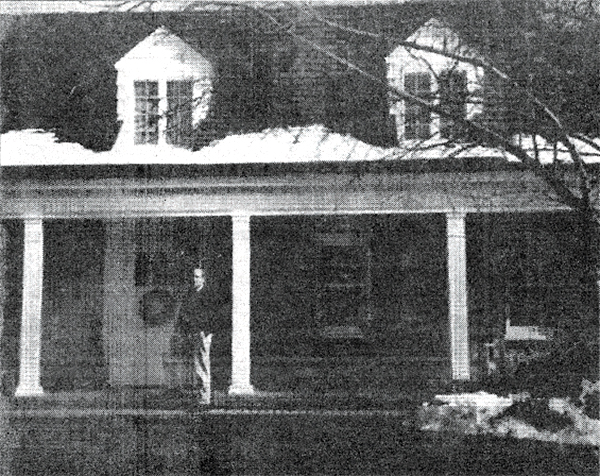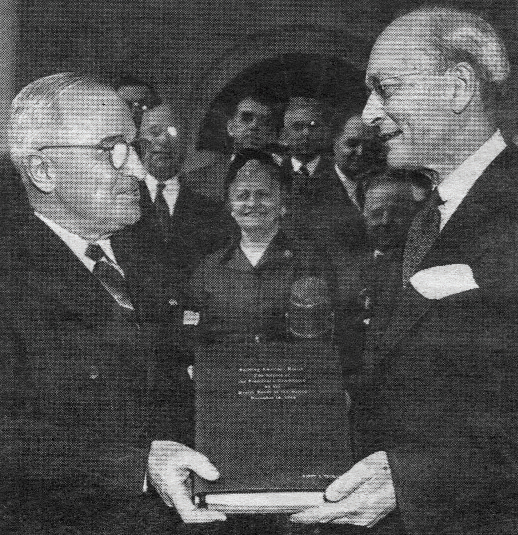Making Dreams Come True | Welcome Home - Moretti’s Barrington
Dr. Paul Magnuson: An American Legend in Medicine
The founder of the Rehabilitation Institute of Chicago and a pioneer in bone and joint medicine found refuge in the Barrington countryside at Pond Gate Farm. In 1940, he became a founding member of the Fox River Valley Hunt.

Paul Magnuson Jr. and his family, daughter Alicia, sons Paul III and David, and wife Marianne Stevenson shown in front of Pond Gate Farm in 1952.
In the early years of the 20th century, many changes came to the somewhat sleepy, but well-run town and country community that was the Village of Barrington and its surrounding farms. With the growth of the North Shore communities largely determined by Chicago’s original elite, a new generation of Chicago’s business and professional leaders came further afield to follow their interests in farming and recreational pursuits such as riding, golf, and landscaping their newly acquired acreage. Some were highly successful in their fields of endeavor, and some would become legend. Some would establish permanent roots here for their descendants and for others their lives would necessitate moving onward. Among the latter was Dr. Paul Magnuson, who would enjoy many halcyon days here away from the extraordinary reality of his life.
Paul Budd Magnuson was born in June 1884 in Merrian, Minnesota, then a suburb of St. Paul. His father was Swedish and his mother of Scottish and English descent. His childhood was a happy one, with several brothers and sisters raised with a sound set of moral and ethical values which he followed throughout his life. His career as a doctor was determined in his early life when, only 7 years old, he assisted the family doctor in the emergency care of his mother. The event made such an impression on him that he never questioned his future as a doctor.
He entered the University of Minnesota in 1903, and two years later he was admitted to the second year of medicine at University of Pennsylvania. Before he graduated from there in 1909, his interest in the structure and growth of bones had led to his pioneering a method of bone lengthening especially for people with uneven leg lengths. This was the beginning of a distinguished career in Orthopedic Surgery. Following his graduation, he came to Chicago and joined the practice of famed Chicago Surgeon Dr. John Murphy. After a year with Dr. Murphy, Magnuson opened his own practice. It was above a saloon on Halstead Street in the heart of the stockyards. He treated slaughterhouse and railroad workers injuries, primarily fractures. He gained a reputation not only for his skill, but for his care of each patient, many of whom could not pay for their treatment, and were never pressed for payment. His was a grueling schedule, which included still working part time with Dr. Murphy. With his growing reputation he joined Dr. William E. Shroeder, Chief of Staff at Chicago’s Wesley Memorial Hospital, and still continued his practice.
After he moved to Chicago and set up his practice, in 1910, he married his childhood sweetheart Alice L. Hasson and a year later their son Paul, Jr. was born. In a few years, he moved his practice to 700 N. Michigan Avenue, joined the faculty of Rush Medical College, and later became professor of surgery and Chairman of the Department of Bone and Joint Surgery at Northwestern Medical School. He also served on the staffs of Passavant and Wesley Memorial Hospital. His care for those injured workmen in the stockyards and railroads had come to the attention of union and business leaders, and in 1916 he was appointed the first medical director of the newly formed Industrial Commission of the State of Illinois.
His career in these and the ensuing years is one of extraordinary accomplishment, not only through his skill as a surgeon, but as a teacher and his leadership abilities in medical studies. But life also carried its worries, as his wife Alice developed severe arthritis. She found some relief in fresh air away from the city.
A Drive Out to Barrington
Sometime in 1925, the Magnusons began driving out Into the Barrington countryside. At whose suggestion is not known, but soon, they bought some land and built a small cottage on a lake in the vicinity of Penny and Healy Roads where they could spend weekends. This was when the countryside west of Barrington was still considered Dundee Township, with open lands uninterrupted to the Fox River. East and West Dundee were closer than the Village of Barrington. Alice Magnuson only enjoyed this for a few years, as she died in 1930. After her death, Magnuson kept increasing his holdings to where he owned and leased almost a thousand acres.
In 1931, he married Laura Thompson, daughter of Mrs. Leverett Thompson of Lake Forest. She had been a patient of his and was 18 years younger. From the first visit she fell in love with what had become Pond Gate Farm. And she wanted a country wedding. Arrangements were made with the historic Barrington Center Church at Old Sutton and Dundee Roads for the ceremony. At that time, the church was unused and in disrepair. Laura’s mother invested $30,000 to restore the building’s roof, painting, and landscaping. It was an investment that may well have saved the church, built by the Methodists in 1853, from total dereliction. The Magnusons honeymooned in Europe, and when they returned set about building Pond Gate Farm into an estate and game preserve. An entry in the inventory of country houses designed by the famed architect David Adler shows that he was commissioned to design a residence for the Magnusons but it was never built. Instead they constructed a stone and clapboard house which would later be described by the architect Robert Coffin as “Hudson River Dutch”.
A Farm in the Country
Barns and buildings were added for their horses, dogs, sheep and milk cows. Magnuson was an avid pheasant and duck hunter, which he could now enjoy on his extensive properties. But he ran up against the game warden who wanted hunters restricted to two birds per day. Insistent that he should not be limited on his own land, Magnuson argued his case, and as a result was granted the first Illinois Department of Conservation tags under a new law that allowed privately raised game to be shot at any time. Magnuson started raising his own bird stock from eggs, releasing them at maturity.

Pond Gate Farm, home to the Magnuson family for nearly 30 years, as it looked in 2000.
In the mid-1930s the Magnusons hired Major Henry Bate as their farm manager, and he established good relations with their neighbors including Edgerton Throckmorton at Hail Weston Farm at the west end of Helm Road. Throckmorton and some fellow landowners, including Virginia Cardwell, had started foxhunting and Bate facilitated the building of paneled jumps on Magnuson’s land.
The Fox River Valley Hunt
By 1939, Henry Bate had gone to manage the North Shore stables of Chicago architect Dennison Bingham Hull who was Master of the Longmeadow Hunt, and who kenneled their hounds in Northbrook. Bate suggested to Hull that he might want to take his hounds out to the country and facilitated this with Throckmorton and Magnuson. The result was an exhilarating day’s ride in which the Longmeadow Hounds were enlivened by the scent of live fox as opposed to following the drag trails that confined them in the North Shore communities. At the end of that day, Hull and Throckmorton agreed to join forces and in 1940, the Fox River Valley Hunt was formed. One of its founding members was Dr Paul Magnuson.
Magnuson continued his practice in Chicago and served on the faculties of the teaching hospitals. His skill and advancements in orthopedic surgery and aftercare of his patients had become renowned. And he was called upon to serve the nation and its veterans as America was drawn into the challenges of the Second World War.
As the war advanced, thousands of men were being returned stateside with wounds that exceeded the abilities of small local civilian hospitals to adequately treat and offer the necessary convalescence. At that time the Veterans Administration hospital system was under the direction of the Civil Service and was in trouble. At the end of the war, President Truman called on General Omar Bradley to head up a commission to sort out a situation that Bradley likened to “teaching a herd of elephants how to ice skate”. Bradley turned to Magnuson to work along with him and the VA’s Chief Medical Director General Paul Hawley to help straighten out the mess. Magnuson took up the challenge, and from 1945 to 1951 he served as director of education and research for the VA and then as its medical director.
A General in the Field
During those years he and Laura would still find refuge at Pond Gate Farm and General Bradley was often their guest. George Van Hagen, writing about Dr. Paul Magnuson for the Barrington Courier Review recalled an anecdote told him by Mrs. Erskine Wilder, who was a daughter of Edgerton Throckmorton. One day, in 1945, she was riding in Magnuson’s woods near Route 72, when she heard gunshots and decided to investigate. She came upon two men with their hunting dogs combing the field for pheasant. Riding closer, she recognized her neighbor, Dr. Magnuson and his companion, Four Star General Omar Bradley.
The changes that Magnuson was contributing to the VA Hospital system received accolades in the Summer 1947 Quarterly Bulletin of Northwestern Medical School. His leadership to bring about the affiliation of VA Hospitals with teaching hospitals and medical schools was considered one of the most important developments in the history of the VA, which became a separate department within the government. The article noted that some two years into Dr. Magnuson’s tenure with the VA, 57 medical colleges, 800 attending men, and 600 outstanding consultants are working with 56 VA hospitals in the residency training program. The magnitude of his contribution to the VA prompted President Truman to ask him to serve the nation one more time. In 1952, after he left the VA, President Truman tasked him to head a commission to “Report on the Health Needs of the Nation”, a position he held for a year.
Founding the Rehabilitation Institute of Chicago
By 1953, Dr. Paul Magnuson was working on his dream project. His goal was to build a hospital where the rehabilitation of patients who had undergone surgery, perhaps suffered paralyzing injuries, or amputations, could be pursued to an ultimate extent of wellness. It was no less than the follow-up care that he had offered to those working men in the grind of the stockyards. He began without any sophisticated fundraising committee, telling his own story, and convincing business leaders of the need for the facility that he envisioned. His reputation preceded him, and in 1954, the Rehabilitation Institute of Chicago opened in a renovated warehouse on Ohio Street. Its development, seeking the foremost and best treatments that could be developed for his patients, would take up the rest of his active life in medicine.
In 1954 too, the Magnusons left Pond Gate Farm to live in Washington, D.C. Perhaps it was time. The western fields and forests of the Barrington countryside, especially in Dundee Township, were giving way to development and increasing traffic. Their lives were increasingly devoted to the Rehabilitation Institute and Magnuson’s advisory work in the Nation’s capital In 1963, leadership of the Rehabilitation Institute of Chicago passed to Dr. Henry Betts, who would carry on Magnuson’s legacy advancing the medical goals of the Institute including construction of its flagship hospital on East Superior Street. Magnuson wrote his autobiography “Ring the Night Bell”, perhaps recalling those injured men who came to his first practice above a saloon on Halstead Street. But it was his successor at RIC, Dr. Henry Betts, who would write the ultimate tribute:
“Dr. Magnuson gave consideration to the needs of the handicapped and to the concept of total rehabilitation earlier than any other physician,” Betts said. “A surgeon, he went beyond this to the nonsurgical approach to the problems of the handicapped. I have never known a physician more beloved by his patients, nor known a man with friends so loyal. He was direct, totally honest, outspoken and uncompromising, with glorious humor and insights. He was one of the last of an era of medical “tycoons”. He was one of the great men of American medicine.”
A Call from a U.S. President
And what of Pond Gate Farm? Its acreage was disbursed through the years, most of it eventually into five-acre parcels. A road was named after the farm. Some acreage remained around the residence, which George Van Hagen visited with Dr. Magnuson’s grandson David almost 20 years ago. Then owners, the Starnes, called their property Carriage Oakes Farm. There was one touching scene on that occasion. David sat at a desk in the library, recalling that it was in the same place as his grandfather’s desk. He remembered the day in 1952, when he was near the desk, and the phone rang. He answered it, and the voice on the other end said: “Is your grandfather home? This is President Truman calling.”
Dr. Paul Magnuson died on November 5, 1968 in Washington, D.C. He had become a legend of American medicine, and in retelling his story here, is to place in the history books, the fact that for almost 30 years of his life, this extraordinary man found refuge in Barrington’s countryside at his beloved Pond Gate Farm. Laura Thompson Magnuson died in 1973 in Washington, D.C.
The author of this article acknowledges with gratitude the prior research of the late George Van Hagen into Dr. Paul Magnuson’s life and work.

Dr. Paul B. Magnuson (on right) presents President Harry S. Truman with a report of “The President’s Commission on the Health Needs of the Nation” in 1952.
A Pioneering Restorative Doctor
The United States Department of Veterans Affairs has never forgotten one of its most distinguished medical directors. In 1998, the “Paul B. Magnuson Award for Outstanding Achievement in Rehabilitation Research and Development” was established and is presented annually to a VA RR&D investigator who exemplifies the entrepreneurship, humanitarianism, and dedication to veterans displayed by Dr. Magnuson during his career.
The award recognizes the importance of rehabilitation research within the VA Health Care System and is the highest honor for VA rehabilitation investigators. It consists of a one-time award of $5,000 to an individual, with $50,000 for up to three years to supplement ongoing peer-reviewed research and with a celebratory plaque.
In establishing the award, Dr. Magnuson was remembered as a bone and joint surgeon who continuously sought new treatments and new devices for assisting his patients as they faced unique situations presented by their disability. The description for the award continues by saying that Dr. Magnuson saw his duty as not only curing, but also as restoring a patient to his family, his job, and his life. He was remembered as a champion of the underdog, as an advocate for veterans, and was the architect of the Department of Veterans Affairs Health Care System as it is known today.
The most recent recipients of the Paul B. Magnuson Award were Linda Resnik in 2017, and Elaine Peskind in 2018, with nominations for the 2019 award already under review.
Thus, is the recognition of this exceptional man’s life and career brought well forward into the 21st century. Not only did he “do no harm”, but he brought hope, encouragement, and a return to productive lives for many who might otherwise be sidelined into uselessness. From the uncounted numbers of those who benefitted from his dedication, he is now remembered for future generations.
